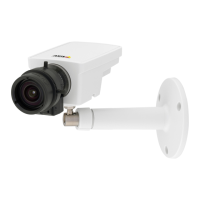
Do you have a question about the Axis M1114 and is the answer not in the manual?
| Maximum resolution | 1280 x 800 pixels |
|---|---|
| Video formats supported | H.264 |
| Camera shutter speed | 1/24500 - 1/6 s |
| Minimum illumination | 0.6 lx |
| Sensor type | CMOS |
| Optical sensor size | 1/4 \ |
| Video motion detection | Yes |
| Supported network protocols | IPv4/v6, HTTP, HTTPS, SSL/TLS, QoS Layer 3 DiffServ, FTP, SMTP, Bonjour, UPnP, SNMPv1/v2c/v3 (MIB-II), DNS, DynDNS, NTP, RTSP, RTP, TCP, UDP, IGMP, RTCP, ICMP, DHCP, ARP, SOCKS |
| Power source type | PoE |
| Dimensions (WxDxH) | 61 x 94 x 43 mm |
| Certification | EN 55022 Class B, EN 61000-3-2, EN 61000-3-3, EN 61000-6-1, EN 61000-6-3, EN 55024, FCC Part 15 Subpart B, Class B, ICES-003 Class B, VCCI Class B, C-tick AS/NZS, CISPR 22, KCC Class A, EN 60950-1 |
| Processor model | ARTPEC-3 |
| Flash memory | 128 MB |
| Operating temperature (T-T) | -20 - 50 °C |
| Operating relative humidity (H-H) | 20 - 80 % |
| Weight | 210 g |
|---|
Information about the manual's scope, intended audience, and applicability.
Covers legal considerations, liability, IP rights, trademarks, and equipment modifications.
Details EMC standards for radio frequency emission and immunity requirements.
Addresses safety standards, regional regulations, and disposal guidance.
Instructions on how to obtain technical assistance and use online support.
Information on accessing Axis learning center for training materials.
Identifies and describes the product's physical connectors and control buttons.
Explains the purpose and usage of the product's control button for various functions.
Step-by-step guide for accessing the product via a web browser.
Instructions for enabling remote access to the product over the internet.
Process for setting the initial administrator root password for secure access.
How to set the power line frequency for optimal image performance.
An overview of the controls and layout of the Live View page.
Describes the interactive controls available on the Live View page.
Guides on configuring and using the manual trigger for action rules.
Details on using Pan, Tilt, and Zoom controls, including preset positions.
Explains how to manage exclusive control of PTZ functions among users.
Explains H.264 streaming methods like Unicast RTP, RTSP, and Multicast RTP.
Describes MJPEG format and AXIS Media Control for video access.
Covers access via still JPEG, Windows Media Player, and QuickTime.
Guides through initial product setup steps like users, TCP/IP, date/time, and video.
Details how to adjust the camera's focus and back focus.
Configuration of video streams, including H.264, MJPEG, and resolution.
Adjusting image quality, frame rate, and using features like pixel counter.
Creating and using predefined stream profiles for quick setup.
Adjusting color, brightness, sharpness, contrast, white balance, and exposure.
Setting up and configuring specific view areas within the camera's field of view.
Adding text and images as overlays on the video stream.
Process for uploading and configuring overlay images like company logos.
Configuring the default viewer for different browsers and viewer settings.
Adding custom links to the Live View page for scripts or external resources.
Managing preset camera positions and configuring automated guard tours.
Configuring advanced PTZ controls, shortcuts, and user access queues.
Setting up alarms for camera tampering events and notifications.
Configuring motion detection windows and tuning parameters like object size and sensitivity.
Procedures for installing applications and managing their licenses.
Considerations for application upgrades, restarts, and factory resets.
Configuring event triggers, conditions, and defining actions for automated responses.
Setting up notifications via email, FTP, HTTP, and defining recipients.
Utilizing schedules and recurrences to trigger events at specific times or intervals.
Accessing, playing, downloading, and configuring video recordings.
Process for installing and managing user interface languages.
Configuring user accounts, roles, and access permissions for the product.
Implementing IP address filtering, HTTPS encryption, and ONVIF for secure access.
Configuring IEEE 802.1X for secure network access using certificates.
Managing security certificates for secure communication.
Setting up IPv4 and IPv6 addresses, including DHCP and static IP.
Configuring AVHS and AXIS Internet Dynamic DNS Service for remote access.
Managing DNS for name resolution and NTP for time synchronization.
Setting host names and customizing HTTP/HTTPS ports.
Configuring NAT traversal for external access through routers.
Managing FTP server, RTSP settings, and SOCKS proxy for network communication.
Configuring QoS to prioritize network traffic and improve reliability.
Setting up SNMP for network management and UPnP for device detection.
Setting up network shares for storing video recordings and data.
Performing product restarts and factory default resets for maintenance.
Accessing support information, system status, and logs for troubleshooting.
Generating logs, reports, and viewing system status for analysis and troubleshooting.
Customizing with scripts, uploading files, and resetting to factory defaults.
Checking, upgrading, and recovering firmware in case of failure.
Resolving issues with IP addressing, network access, router, and firewall configurations.
Resolving problems with H.264/MJPEG streaming, image quality, and frame rates.
Troubleshooting issues with storage, recordings, and SD card mounting.
Detailed specifications for camera, video compression, resolutions, frame rate, network security, and protocols.
Specifications for system integration, software, casing, memory, power, connectors, and environment.
Discussion of factors affecting system performance, bandwidth, and frame rate.